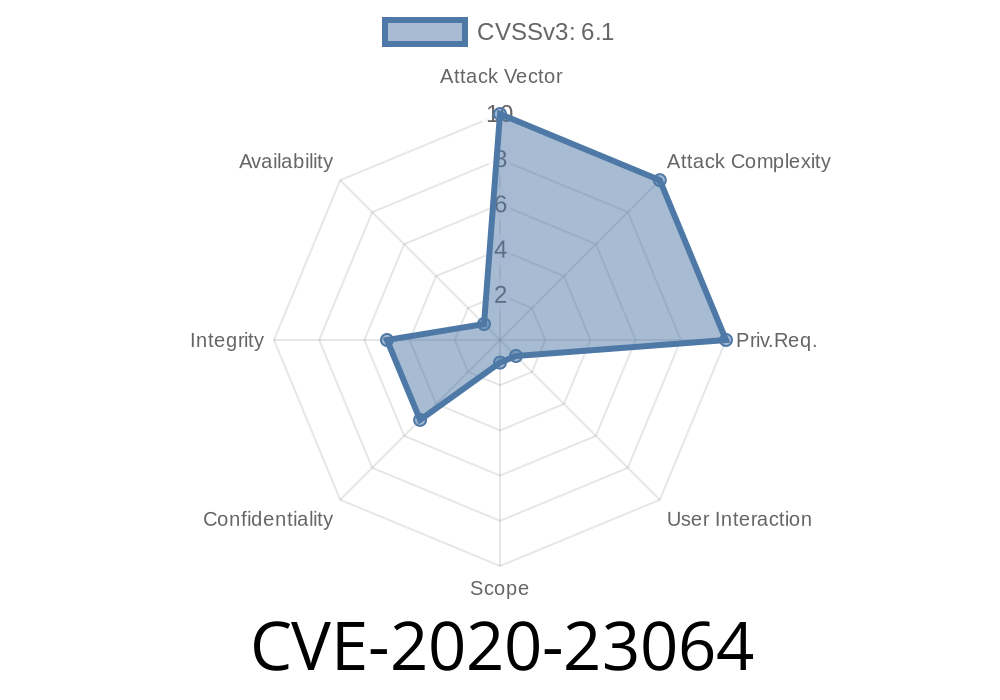The CVE-2020-23064 is a significant security vulnerability affecting jQuery, a widely adopted JavaScript library that simplifies common web tasks like DOM manipulation and event handling. More precisely, versions 2.2. through 3.x before 3.5. are vulnerable. The flaw lies in a Cross-Site Scripting (XSS) bug, which could enable remote attackers to execute arbitrary code on a victim's system, potentially leading to loss of sensitive data or control over the affected webpage.
This blog post discusses the vulnerable jQuery versions, delves into the specifics of CVE-2020-23064, and provides tips on how to mitigate the risk of a possible exploit. Throughout the post, we will link to the original references and analyze code snippets and exploit details that exemplify the vulnerability.
Vulnerable Versions
jQuery versions 2.2. to 3.x before 3.5. are susceptible to the security flaw CVE-2020-23064 due to a mismanaged element. Web developers using these versions should update their jQuery library to version 3.5. or later immediately to prevent possible threats.
Vulnerability Details
According to the original reference jQuery Security Advisory, the XSS vulnerability CVE-2020-23064 originates from the way jQuery handles nested elements within tags.
A code snippet that demonstrates the vulnerability
<!-- Vulnerable code -->
<!DOCTYPE html>
<html>
<head>
<script src="https://code.jquery.com/jquery-3.4.1.js"></script>;
</head>
<body>
<select>
<option>Hello</option>
<option>
Goodbye
<img src="x" onerror="alert('XSS!')">
</option>
</select>
<script>
// Copying the HTML above to a new element:
$('#container').html($('select').html());
</script>
</body>
</html>
In this example, we have an
tag with an "onerror" attribute that triggers an XSS Alert within an tag. A remote attacker could potentially exploit this vulnerability by injecting malicious code into the tag, remotely compromising the victim's system.
Exploit details
To execute an exploit using the vulnerability, an attacker would need to manipulate the element containing nested elements. The attacker may inject a malicious tag preceded by a closing </select> tag to overcome the browser's protection mechanisms.</p><h2>A potential exploit example can look like this</h2><p><pre><code class="language-HTML"><!-- Malicious code --> <select> <option value="normal_choice">Normal Choice</option> <option> Attack Choice </select><script>alert('You have been hacked!')</script><select> <!-- End of the malicious code --> </option> </select> </code></pre>The exploit manifests itself when vulnerable jQuery executes a function that interacts with this <select> element. It might be a simple retrieval of the <select> HTML structure, as illustrated in the vulnerable code snippet above.</p><h2>To safeguard against the risk of an exploit, developers should take the following steps</h2><p>1. Update jQuery to version 3.5. or the most recent version. This release addresses the vulnerability and patches the security risk. The <a href="https://jquery.com/download/" rel="nofollow">official jQuery site</a> (https://jquery.com/download/) provides the latest updates.<br><br>2. Sanitize user input whenever handling or displaying HTML content from a user. Input validation libraries like <a href="https://github.com/cure53/DOMPurify" rel="nofollow">DOMPurify</a> (https://github.com/cure53/DOMPurify) can significantly reduce the possibilities of an XSS attack.</p><h2>Conclusion</h2><p>The XSS vulnerability CVE-2020-23064 in jQuery versions 2.2. through 3.x before 3.5. poses a potential threat to web application security. Be sure to update the jQuery library, sanitize user input, and inform the developer community regarding this critical issue. These methods can mitigate the vulnerability and keep your applications secure.</p><h2>Timeline</h2><p>Published on: 06/26/2023 19:15:00 UTC<br/>Last modified on: 07/25/2023 15:15:00 UTC</p></body>
